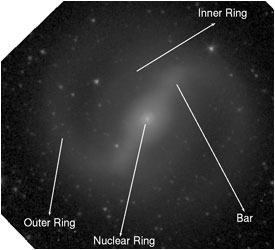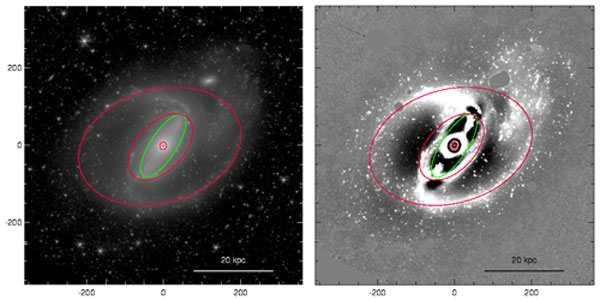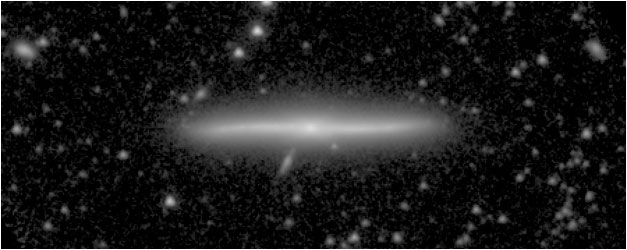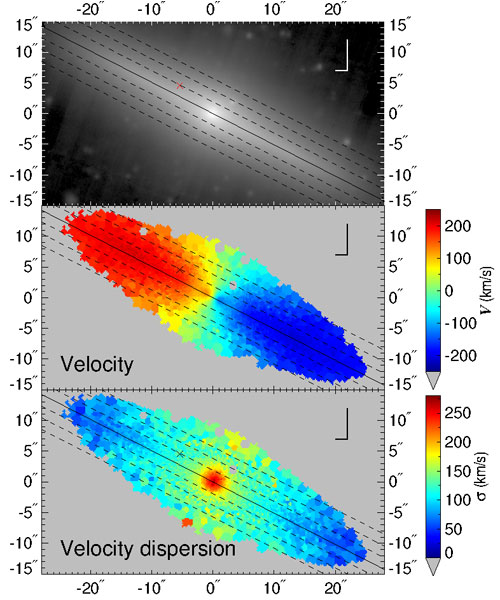Galactic Rings and Thick Discs
Galactic Rings
Many of the most spectacular galaxies are spiral galaxies. Those galaxies have a disc with bright spiral arms, where usually enhanced
star formation occurs.
Spiral galaxies often host a bar. A bar is an elongated structure made of stars. Bars break the symmetry of the galaxies. In a symmetric galaxy,
orbits would be close to circular, but in a barred galaxy the orbits of stars and gas clouds are perturbed.
Gas clouds perturbed by bars are moved to certain orbits that are said to be resonant with the bar. Gas accumulates there. When gas density becomes high
enough clouds collapse under their own gravity and star formation begins. This is the origin of the so-called resonance rings.
Resonance rings are beautiful closed or almost closed structures. Their intrinsic shape is almost round, and very elliptical rings are rare.
Often, strong star formation happens in them. However, even after the gas has gone, a stellar ring remains visible.
Depending on the position of the ring with respect to the bar we can distinguish three ring flavours that are linked to different resonant orbits:
- Rings that are about twice as large as the bar are called outer rings.
- Rings that are just outside the bar are called inner rings.
- Rings that are well inside the bar are called nuclear rings.
The study of rings is important because they are a manifestation of the perturbations caused by bars in galaxies. By studying them we can unveil the mysteries on how bars reshape the galaxies.
In Oulu University we have made an Atlas of rings called the Atlas of Resonance Rings As Known In the S4G (ARRAKIS). The S4G is made of space-based mid-infrared images of 2352 nearby galaxies. ARRAKIS includes measurements (shape, orientations, ...) on all the rings that could be detected on those galaxies. ARRAKIS provides a wealth of observational information on rings that, in combination with numerical simulations can be used to obtain a better understanding of the dynamics in galaxies.

S4G picture of NGC 4314, a spiral galaxy with a bar, and the three flavours of rings. Image credit:

ARRAKIS image corresponding to NGC 1097. The ring outlines are marked in red and the bar outline is marked in green.
The right image is a model-subtracted image where the light of smooth parts of the disc, the bar, and the bulge are subtracted so the rings and
the arms appear contrast-enhanced.
Thick Discs
When looked edge-on, the discs of galaxies are seen to be made of two components. The thinnest one is the thin disc. Thin discs are the host of star formation and have vertical extensions of a few hundred parsecs. Thick discs are vertically more extended and contain old stars that are usually almost as old as the universe itself.
Thick discs are interesting because they contain some of the oldest stars in galaxies. They are a window to the infancy of the universe when the first stars were born. If we were able to understand how thick discs formed we would then obtain a lot of information on the conditions in which galaxies formed and had the first steps of their evolution.
At the Astronomy Research Unit of the University of Oulu we carefully study nearby thick discs in order to understand their formation mechanisms. The research approach consisting in studying nearby objects in detail in order to figure out their origin and history is called Galactic Archæology.
We have adopted a multi-wavelength approach to the problem. We first studied thick disc using mid- infrared imaging of nearby galaxies. We are now producing a large-scale spectroscopic survey of several tens of edge-on galaxies with MUSE, an integral field spectrograph at the VLT. Our goal is to obtain the kinematics and the star formation history of thick discs in the nearby universe with an exquisite level of detail that will allow us to unveil the mysteries of the origin of galaxies.

An NGC 522 image made with data from the Spitzer Survey of Stellar Structure in Galaxies (S4G).
The NGC 522 image was produced by adding the 3.6 μm and 4.5 μm bands of the survey. This almost perfectly edge- on galaxy shows a boxy-shaped
bulge and a warp.
The small influence of dust in the mid-infrared and the great depth of the image allows us to easily study the thick and thin disc components
of NGC 522.


